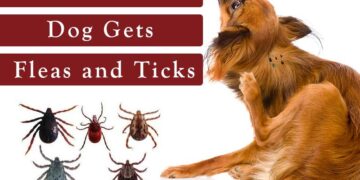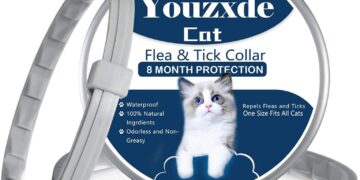Table of Contents
Introduction: The Heartbreak of a Never-Ending Itch
Early in my veterinary career, I met Barney, a beautiful Golden Retriever whose life had become a torment of incessant itching.
His owner, a wonderfully diligent woman, brought him to my clinic in a state of shared desperation.
Barney’s skin, particularly around his tail and hindquarters, was a raw, red landscape of self-inflicted wounds.
He was miserable, and his owner was at her wit’s end, having tried every on-pet treatment she could find.
My initial approach was textbook.
I prescribed the most advanced topical treatments, medicated shampoos to soothe his inflamed skin, and even courses of steroids to break the inflammatory cycle.1
We would see temporary relief; the frantic scratching would subside, and patches of fur would begin to regrow.
But inevitably, like a recurring nightmare, the itch would return with a vengeance, and Barney would be back at square one.1
Each relapse was a fresh wave of frustration for his owner and a professional puzzle for me.
I was treating the dog, but I wasn’t solving the problem.
The turning point—the “aha” moment—didn’t come from a new drug, but from a deep-dive conversation with a board-certified veterinary dermatologist.3
As I laid out Barney’s case, she stopped me and reframed the entire situation.
I wasn’t just fighting a pest on a dog; I was fighting an entrenched ecological system in the owner’s home.
The fleas I occasionally found on Barney were, she explained, merely the tip of a massive, invisible iceberg.
This report is built on that transformative understanding.
To truly grasp why fleas are so much more than a simple nuisance—and why they are unequivocally bad for dogs—one must look beneath the surface.
The answer lies not just on your dog, but in the 95% of the infestation hiding in your home and yard.4
Winning this war requires a comprehensive, two-front strategy, one that acknowledges the full scope of the flea iceberg.
Part 1: The Tip of the Iceberg – The Visible Dangers on Your Dog (The 5%)
The adult fleas that pet owners see on their dogs represent the most visible part of the problem, but this small fraction can cause immense and immediate harm.
These direct health risks are what typically drive a pet owner to seek veterinary care.
Flea Allergy Dermatitis (FAD): An Immune System in Overdrive
The most common skin disease diagnosed in domestic dogs is Flea Allergy Dermatitis, or FAD.6
It’s crucial to understand that FAD is not a simple irritation from flea bites.
It is a true allergic disease—a profound hypersensitivity reaction to proteins and antigens present in flea saliva.8
When an allergic dog is bitten, its immune system launches an exaggerated inflammatory response, leading to intense, persistent itching known as pruritus.6
This allergic cascade is wildly disproportionate to the number of fleas present.
In a highly sensitive dog, a single flea bite can trigger a miserable cycle of itching that lasts for weeks, long after the offending flea is gone.2
This “one-bite phenomenon” is a major source of confusion for owners.
They may diligently comb their dog, find no evidence of live fleas, and wrongly conclude that something else, like a food allergy, must be the cause of the misery.1
The reality is that the damage was done by a transient flea that fed and left days or even weeks prior, leaving behind a smoldering fire of allergic inflammation.1
The absence of visible fleas, therefore, does not rule out FAD.
The consequences of this unrelenting itch are severe.
Dogs will scratch, lick, chew, and bite at themselves, primarily targeting the lower back, base of the tail, rump, and inner thighs.1
This self-trauma leads to a host of secondary problems:
- Hair loss (alopecia), often in a characteristic “pants” pattern over the hindquarters.9
- Red, inflamed skin (erythema), scabbing, and open sores.9
- Secondary bacterial and yeast infections, commonly called “hot spots” (pyotraumatic dermatitis), which develop in the damaged skin and require antibiotic or antifungal treatment.6
- Behavioral changes, including stress, anxiety, restlessness, and a significant decline in the dog’s quality of life.9
Flea Anemia: The Life-Threatening Cost of Blood Loss
Fleas are hematophagous, meaning they feed on blood.11
While a single flea consumes a tiny amount, a heavy infestation can lead to substantial blood loss, resulting in a life-threatening condition called flea anemia.9
A single female flea can ingest up to 15 times her own body weight in blood over her lifespan, so it is easy to see how hundreds of fleas can pose a mortal threat.13
This condition is a medical emergency, particularly for the most vulnerable populations:
- Puppies and kittens, whose small bodies cannot spare the blood volume and whose immune systems are still developing.9
- Senior dogs, who may already be weakened by other health issues and are often less efficient groomers.9
- Small or toy breed dogs and any animal with a pre-existing illness or compromised immune system.9
A particularly insidious aspect of flea anemia is that it can develop silently.
A dog that is not allergic to flea saliva may harbor a massive number of fleas without displaying the frantic itching associated with FAD.8
An owner might see the absence of scratching as a sign that there is no significant flea problem.
Meanwhile, the large, quiet population of parasites is steadily draining the pet’s lifeblood.
The initial signs of anemia—lethargy and weakness—are subtle and easily dismissed as normal aging or tiredness.9
By the time the most definitive clinical sign appears—pale gums that have turned from a healthy pink to a stark white or gray—the condition is often critically advanced.12
For this reason, flea anemia can be a silent killer, underscoring the necessity of proactive flea control and regular physical checks, regardless of whether a dog appears itchy.
Immediate veterinary intervention, often involving blood transfusions and aggressive flea eradication, is required to save the animal’s life.9
Part 2: Below the Waterline – The Invisible Threats Fleas Carry
Beyond the direct damage they inflict, fleas serve as vectors, or carriers, for a host of other diseases and parasites.
These indirect threats represent the dangers lurking just below the surface of the iceberg, transforming a simple pest problem into a complex medical issue.
The Tapeworm Trojan Horse (Dipylidium caninum)
The most common tapeworm in dogs and cats, Dipylidium caninum, is transmitted almost exclusively by fleas.8
This process is an elegant and sinister example of indirect transmission.
Flea larvae, living in the dog’s environment, consume tapeworm eggs.18
Inside the flea, the egg develops into an immature form called a cysticercoid.8
The cycle completes when a dog, in the process of grooming itself, accidentally swallows one of these infected fleas.16
The larva is then released in the dog’s digestive tract, where it matures into an adult tapeworm that attaches to the intestinal wall.8
Most tapeworm infections cause no obvious signs of illness.19
The clearest evidence an owner might see is the presence of proglottids—the tapeworm’s egg-filled segments—in the dog’s feces or on the fur around its anus.18
When fresh, these segments resemble small, white, mobile grains of rice; when dry, they look like hard, yellowish specks.18
Some dogs may exhibit anal itching, leading to the classic “scooting” behavior.16
The presence of tapeworms serves as an undeniable diagnostic marker.
It is definitive proof that the dog has ingested a flea, and therefore, that a flea population exists somewhere in the pet’s environment.
Even if an owner has never seen a single flea on their pet, a tapeworm diagnosis confirms an infestation and should trigger the immediate start of a comprehensive, integrated flea control program.
The Stealth Invader: Bartonellosis (“Cat Scratch Disease”)
Fleas are also vectors for bacteria, most notably Bartonella.
While often called “Cat Scratch Disease,” several species of this bacteria can infect dogs, transmitted by fleas, ticks, and other biting insects.23
Bartonellosis is a master of disguise, causing a wide array of vague, intermittent, and seemingly unrelated symptoms that make it notoriously difficult to diagnose.16
This disease is a “great imitator.” An owner might bring their dog to the vet for a shifting leg lameness, a persistent low-grade fever, nosebleeds, or inflammation of the eyes (uveitis).24
In severe cases, it can cause life-threatening inflammation of the heart lining (endocarditis).27
Because these symptoms are so varied, and because an owner may not think to mention a past or minor flea issue, the connection is often missed.
Standard blood work may be inconclusive, and diagnosis requires specialized tests that a veterinarian might not consider without a high index of suspicion.9
The disease is likely underdiagnosed in the canine population.26
Bartonellosis demonstrates how a seemingly “simple” flea problem can escalate into a serious systemic illness, leading to a frustrating and expensive diagnostic journey.
It elevates the flea from a mere skin irritant to a potential trigger for chronic, debilitating disease.
This risk adds significant weight to the argument for aggressive, year-round flea prevention.
Furthermore, since humans can also be infected, controlling fleas on pets becomes a matter of public health.11
Part 3: Understanding the Ocean – The Flea Life Cycle is Your Home’s Ecosystem
The central epiphany in understanding flea control—the paradigm shift that separates success from failure—is recognizing that the fight is not with the fleas on your dog.
The real war is against the massive, hidden population thriving in your home environment.
The 95/5 Rule: Unveiling the Flea Iceberg
The adult fleas you see on your pet are just the tip of the iceberg, constituting only 5% of the total flea population in an active infestation.4
The other 95%—the immense, invisible mass of the iceberg—is made up of immature life stages: eggs, larvae, and pupae.28
These stages are not on your pet; they are developing in your environment.
They are in your carpets, your pet’s bedding, the cracks in your floorboards, and under your furniture.4
This single fact explains why simply treating the pet is a strategy doomed to fail.
It’s like trying to bail out a boat with a thimble while ignoring the gaping hole in the hull.
For every adult flea you kill on your dog, there are 19 more in various stages of development, waiting to mature and re-infest your P.T.4
The Four-Stage Invasion Force
The flea life cycle is a highly efficient system of reproduction and survival, composed of four distinct stages.31
- Stage 1: Egg (50% of the Population): An adult female flea is an egg-laying machine, producing up to 40-50 eggs per day after a blood meal.5 These tiny, oval eggs are not sticky. They are laid on the host but fall off almost immediately, turning your dog into a living salt shaker that seeds the environment with the next generation of fleas.31 They accumulate in the highest concentrations where your pet sleeps and rests, hatching into larvae in 1 to 10 days.32
- Stage 2: Larva (35% of the Population): The newly hatched larvae are maggot-like and mobile. They instinctively avoid light, burrowing deep into carpet fibers, under furniture, and into dark crevices.31 They feed on organic debris and, critically, “flea dirt”—the digested blood excreted by adult fleas that also falls from the pet.35 This larval stage lasts for 5 to 20 days before they begin the next transformation.32
- Stage 3: Pupa (10% of the Population): The larva spins a protective, silk-like cocoon around itself, entering the pupal stage. This is the final transitional phase before becoming an adult.35
- Stage 4: Adult (5% of the Population): This is the familiar, blood-sucking stage that lives on the host animal.31
The Pupal Bunker: The Secret to Flea Persistence
The pupal stage is, without question, the most resilient phase of the flea life cycle and the number one reason why flea control efforts fail.37
The cocoon it spins is not only protective but also sticky, quickly becoming camouflaged with dust, carpet fibers, and other debris.37
This “bunker” makes the pupa almost impervious to insecticides, freezing, and drying.31
This stage functions as an environmental time bomb.
Flea pupae can remain dormant in their cocoons for weeks, months, or in some cases, up to a year, waiting for the right signals that a host is nearby.37
These triggers are the very signs of life in your home: vibrations from footsteps, the warmth of a body, and the carbon dioxide you and your pet exhale.32
This explains the frustrating phenomenon of sudden re-infestation.
An owner can treat their pet, vacuum the house, and believe the problem is solved.
But weeks or months later, the vibrations from the vacuum cleaner, the heat turning on in the winter, or the family returning from vacation can trigger a mass, coordinated emergence of new adult fleas from their dormant pupal bunkers.39
The house is suddenly teeming with fleas again, seemingly from nowhere.
This isn’t a failure of the initial treatment; it’s the hatching of the hidden reserves.
This reality makes a sustained, long-term control strategy—one that outlasts the pupal stage—absolutely non-negotiable.
Table 1: The Flea Life Cycle at a Glance
| Stage | % of Population | Location | Duration | Key Characteristics | Control Method |
| Egg | ~50% | Environment (carpets, bedding) | 1-10 days | Tiny, white, non-sticky; falls off host.31 | Thorough vacuuming; washing bedding in hot water; Insect Growth Regulators (IGRs).29 |
| Larva | ~35% | Environment (deep in carpets, cracks) | 5-20 days | Maggot-like, avoids light, feeds on flea dirt.31 | Thorough vacuuming; IGRs; environmental sprays.13 |
| Pupa | ~10% | Environment (deep in carpets, under furniture) | Weeks to a year | Resilient, sticky cocoon; camouflaged; resistant to insecticides.37 | Persistent vacuuming to trigger hatching; long-term on-pet treatment to kill emerging adults.38 |
| Adult | ~5% | On the pet | Weeks to months | Feeds on blood, lays eggs, mobile.31 | On-pet preventative products (oral, topical, collar).13 |
Part 4: A Two-Front War – The Integrated Strategy for a Flea-Free Life
Accepting the “flea iceberg” paradigm means accepting that victory requires fighting a two-front war simultaneously: one front on your dog, and the other in your home and yard.
An integrated pest management (IPM) approach is the only path to success.41
Front 1: Defending Your Dog (On-Pet Treatment)
The goal of treating your dog is twofold.
First, it is to provide immediate relief by killing the adult fleas that are causing discomfort and disease.
Second, and just as important, it is to turn your pet into a “flea vacuum”—an active agent in decontaminating the environment by killing newly emerged fleas before they have a chance to feed and lay eggs.42
There are several excellent classes of modern preventatives, and the best choice depends on your dog’s health, lifestyle, and your household situation.
- Oral Medications (Chewables): Products like NexGard, Bravecto, and Simparica are given by mouth and work systemically.45 When a flea bites the treated dog, it ingests the medication and dies very quickly, often within hours.45 This is highly effective at breaking the life cycle. Their main advantages are ease of administration, lack of messy residue, and the fact that their efficacy is not diminished by bathing or swimming.47 The primary consideration is that the flea must bite the pet to be killed. In a tiny fraction of dogs, some products in this class have been associated with neurological side effects like tremors or seizures, so they should be used with caution in dogs with a known history of seizure disorders.49
- Topical Treatments (Spot-ons): Products like Frontline Plus and Advantage II are applied to the skin and spread through the body’s natural oils.51 Many kill fleas on contact, meaning the flea doesn’t have to bite to die, and some also have repellent properties.49 However, they can be messy to apply, must reach the skin to be effective (which can be difficult in thick-coated dogs), and their effectiveness can be reduced by frequent bathing.48
A critical safety note: Any topical product containing permethrin (e.g., K9 Advantix II) is extremely toxic to cats and should never be used on them or in households where a cat might come into close contact with a treated dog before the product is dry.49 - Flea Collars: Modern collars like Seresto are a significant advancement over old technology. They work by slowly releasing active ingredients over a very long period—up to eight months.45 This makes them cost-effective and low-maintenance. For a collar to be effective, it must be applied snugly enough to make consistent contact with the dog’s skin.49
Table 2: A Comparative Guide to On-Pet Flea Treatments
| Treatment Type | How It Works | Speed of Kill | Duration | Pros | Cons & Safety Notes |
| Oral (Chewable) | Systemic; flea bites pet and ingests medication.47 | Fast (30 mins – 8 hrs).45 | 1 to 3 months.46 | No residue; not affected by bathing; easy to give.47 | Flea must bite; rare neurologic side effects in susceptible dogs.48 |
| Topical (Spot-on) | Spreads through skin oils; some kill on contact.51 | Fast (within 12 hrs).51 | ~1 month.51 | Some repel pests; many OTC options available.49 | Can be messy; efficacy reduced by bathing; risk of cat toxicity with some products.48 |
| Collar | Slow release of active ingredients over the skin.52 | Slower (24-48 hrs).45 | Up to 8 months.45 | Long-lasting; low maintenance; cost-effective.55 | Must have skin contact; efficacy reduced by frequent swimming; potential snag hazard.49 |
Front 2: Sanitizing the Environment (Home & Yard Treatment)
This is the front where the war is truly won or lost.
No on-pet product alone can overcome a heavily infested environment.
Failure to address the 95% of the flea population hiding in your home guarantees re-infestation.29
The indoor strategy follows a simple but rigorous protocol: Vacuum, Wash, Treat.
- Vacuum Thoroughly and Frequently: This is your most powerful weapon. Daily vacuuming, especially with a model that has a beater bar, physically removes a large percentage of eggs, larvae, and flea dirt.41 Critically, the vibrations also stimulate the resilient pupae to hatch into vulnerable adults, which can then be killed by the vacuum or your on-pet preventative.13 Concentrate on pet resting areas, under furniture, and along baseboards. After each session, seal the vacuum bag in plastic and dispose of it in an outdoor trash can immediately.13
- Wash Everything in Hot Water: All pet bedding, blankets, and washable rugs must be laundered in hot water (at least 60°C or 140°F) to kill all flea life stages.29
- Treat with an Insect Growth Regulator (IGR): To break the life cycle chemically, use an environmental spray containing an IGR like methoprene or pyriproxyfen.13 These compounds are safe for mammals but prevent flea eggs and larvae from maturing into adults.44 Spray carpets, under furniture, and other “hot spots.”
For the yard, focus efforts on shady, moist areas where pets and wildlife rest, such as under decks, porches, and bushes.13
Keeping the lawn mowed and clearing leaf litter will make the environment less hospitable to fleas.58
While many “natural” remedies exist, they are generally insufficient for an established infestation.
Products like diatomaceous earth (DE) or borax can help desiccate and kill some fleas and larvae, but they are messy and do not affect the protected pupae.61
Essential oils are primarily repellents and must be used with extreme caution, as many are toxic to pets, especially cats.63
Conclusion: Becoming the Master of Your Home’s Ecosystem
I often think back to Barney.
The day we finally broke the cycle of his itching was a victory for him, for his owner, and for my own understanding as a veterinarian.
The solution wasn’t a single magic bullet.
It was the implementation of the two-front war: a consistent, effective oral preventative for Barney, combined with his owner’s meticulous and relentless campaign to vacuum, wash, and treat their home environment.
Barney’s skin healed, his golden coat grew back thick and lustrous, and his happy, playful personality returned.
A flea infestation is not a moral failing or a sign of a dirty home; it is a biological reality driven by a resilient and highly adapted parasite.
By understanding the flea’s life cycle and the true nature of the “iceberg” problem, pet owners can move from a state of reactive frustration to one of proactive control.
The ultimate takeaway is that lasting flea freedom is not achieved with a single product, but with a sustained, integrated strategy.
Year-round, uninterrupted use of an effective on-pet preventative is the first pillar.42
The second is constant environmental vigilance.
Together, these two pillars transform a pet owner from a helpless victim of infestation into the empowered master of their home’s ecosystem, ensuring a healthy, comfortable, and flea-free life for their dog.
Works cited
- Fleas & Flea Allergy | Animal Dermatology Group, accessed August 2, 2025, https://www.animaldermatology.com/services/flea-flea-allergy
- Flea Allergic Dermatitis in Dogs: Urgent Signs & Rapid Relief Guide, accessed August 2, 2025, https://gsvs.org/blog/urgent-flea-allergic-dermatitis-dogs/
- 3 Ways to Help Your Clients Have an “Aha Moment” | LifeLearn Inc., accessed August 2, 2025, https://www.lifelearn.com/2020/07/20/3-ways-to-help-clients-have-aha-moment/
- What To Do About Fleas – NexGard, accessed August 2, 2025, https://nexgardforpets.com/education/parasites/what-to-do-about-fleas
- REALITY CHECK: The truth about fleas and your pets! – Woodstock Veterinary Hospital, accessed August 2, 2025, https://woodstockvetclinic.com/reality-check-the-truth-about-fleas-and-your-pets/
- Flea Allergy Dermatitis in Dogs and Cats – Integumentary System – Merck Veterinary Manual, accessed August 2, 2025, https://www.merckvetmanual.com/integumentary-system/fleas-and-flea-allergy-dermatitis/flea-allergy-dermatitis-in-dogs-and-cats
- Fleas in Dogs and Cats – Integumentary System – Merck Veterinary Manual, accessed August 2, 2025, https://www.merckvetmanual.com/integumentary-system/fleas-and-flea-allergy-dermatitis/fleas-in-dogs-and-cats
- Fleas – MSD Animal Health Republic of Ireland, accessed August 2, 2025, https://www.msd-animal-health.ie/species/dogs/fleas/
- The Health Risks of Fleas and Ticks – AAHA, accessed August 2, 2025, https://www.aaha.org/resources/the-health-risks-of-fleas-and-ticks/
- Flea Allergy Dermatitis in Dogs: Everything a Pet Parent Needs to Know | PetMD, accessed August 2, 2025, https://www.petmd.com/dog/conditions/skin/flea-allergy-dermatitis-dogs-everything-pet-parent-needs-know
- About Fleas – CDC, accessed August 2, 2025, https://www.cdc.gov/fleas/about/index.html
- Flea Anemia in Cats and Dogs – Veterinary Partner – VIN, accessed August 2, 2025, https://veterinarypartner.vin.com/default.aspx?pid=19239&id=4951428
- Flea Control in Dogs | VCA Animal Hospitals, accessed August 2, 2025, https://vcahospitals.com/know-your-pet/flea-control-in-dogs
- firstvet.com, accessed August 2, 2025, https://firstvet.com/us/articles/flea-anemia-in-dogs-and-cats#:~:text=Several%20fleas%20on%20a%20very,immune%20systems%20are%20still%20developing.
- Flea Anemia in Cats and Dogs – Urban Animal Veterinary Hospital, accessed August 2, 2025, https://urbananimalveterinary.com/fleas/flea-anemia-in-cats-and-dogs/
- Can Fleas Make a Dog Sick? 4 Health Problems | 1st Pet Vet, accessed August 2, 2025, https://1stpetvet.com/4-health-problems-fleas-can-create-for-your-dog/
- Flea Infestation & Flea Anemia in Pets: When to Seek Urgent Care in the Bay Area, accessed August 2, 2025, https://urgentpetcare.com/flea-infestation-flea-anemia-in-pets-when-to-seek-urgent-care-in-the-bay-area/
- Tapeworms | Cornell University College of Veterinary Medicine, accessed August 2, 2025, https://www.vet.cornell.edu/departments-centers-and-institutes/riney-canine-health-center/canine-health-information/tapeworms
- About Dog or Cat Tapeworm Infection – CDC, accessed August 2, 2025, https://www.cdc.gov/dipylidium/about/index.html
- www.cdc.gov, accessed August 2, 2025, https://www.cdc.gov/dipylidium/about/index.html#:~:text=Causes-,Dogs%20and%20cats%20get%20Dipylidium%20tapeworm%20by%20swallowing%20a%20flea,pass%20in%20the%20animal’s%20stool.
- Dog Tapeworms – Causes, Treatments, and Prevention – WebMD, accessed August 2, 2025, https://www.webmd.com/pets/dogs/dog-tapeworms-symptoms-treatments
- Fleas and Flea-borne Diseases Updated – WSAVA 2018 Congress – VIN, accessed August 2, 2025, https://www.vin.com/apputil/content/defaultadv1.aspx?id=8896635&pid=22915&
- www.petmd.com, accessed August 2, 2025, https://www.petmd.com/dog/conditions/infectious-parasitic/c_dg_bartonellosis#:~:text=Bartonellosis%2C%20commonly%20known%20as%20cat,from%20these%20bugs%20and%20parasites.
- Bartonella Infection in Dogs – PetMD, accessed August 2, 2025, https://www.petmd.com/dog/conditions/infectious-parasitic/c_dg_bartonellosis
- Bartonellosis – MSPCA-Angell, accessed August 2, 2025, https://www.mspca.org/angell_services/bartonellosis/
- Bartonella Infection in Dogs – Causes, Treatment and Associated Conditions – Vetster, accessed August 2, 2025, https://vetster.com/en/conditions/dog/bartonella-infection
- Veterinary Guidance for Bartonella – CDC, accessed August 2, 2025, https://www.cdc.gov/bartonella/hcp/veterinarians/index.html
- The Power of Flea Protection | NexGard® Brand Products, accessed August 2, 2025, https://nexgardforpets.com/parasites/about-fleas
- integrated flea control – Turramurra Veterinary Hospital, accessed August 2, 2025, https://www.turramurravet.com.au/wp-content/uploads/2017/08/Flea-Control.pdf
- Fleas – Illinois Department of Public Health, accessed August 2, 2025, https://dph.illinois.gov/topics-services/environmental-health-protection/structural-pest-control/fleas.html
- Fleas | Cornell University College of Veterinary Medicine, accessed August 2, 2025, https://www.vet.cornell.edu/departments-centers-and-institutes/riney-canine-health-center/canine-health-information/fleas
- Flea Lifecycles – CDC, accessed August 2, 2025, https://www.cdc.gov/fleas/about/flea-lifecycles.html
- Flea Life Cycle & Life Stages | How Long Do Fleas Live? – Orkin, accessed August 2, 2025, https://www.orkin.com/pests/fleas/flea-life-cycle
- Life Cycle of Fleas: What Pet Parents Need To Know | Chewy, accessed August 2, 2025, https://www.chewy.com/education/cat/flea-and-tick/life-cycle-of-fleas
- Understanding the Flea Life Cycle, accessed August 2, 2025, https://vetcarebelmont.com/understanding-the-flea-life-cycle/
- Flea Life Cycle Explained: Understanding Fleas in 4 Stages – Wondercide, accessed August 2, 2025, https://www.wondercide.com/blogs/news/flea-life-cycle-the-4-stages
- What Do Flea Pupae Look Like? – Anipetshop, accessed August 2, 2025, https://anipetshop.com/dog-flea/pupae/
- Fleas – Cornell CALS, accessed August 2, 2025, https://cals.cornell.edu/integrated-pest-management/outreach-education/whats-bugging-you/fleas
- Springtime is Flea Time: How to Protect Your Pets – Twin Maples Veterinary Hospital, accessed August 2, 2025, https://twinmaplesvethospital.com/springtime-is-flea-time-how-to-protect-your-pets/
- Can Fleas Live In The Winter? | Dix Hills Animal Hospital, accessed August 2, 2025, https://dixhillsanimalhospital.com/blog/can-fleas-live-in-winter/
- Fleas | Ohioline – The Ohio State University, accessed August 2, 2025, https://ohioline.osu.edu/factsheet/HYG-2081-11
- The Case for Year-Round Flea and Tick Control – Companion Animal Parasite Council, accessed August 2, 2025, https://capcvet.org/articles/the-case-for-year-round-flea-and-tick-control/
- Fleas Management Guidelines–UC IPM, accessed August 2, 2025, https://ipm.ucanr.edu/home-and-landscape/fleas/pest-notes/
- How to Get Rid of Fleas | Texas A&M AgriLife Extension Service, accessed August 2, 2025, https://agrilifeextension.tamu.edu/library/insects/controlling-fleas/
- Effective Flea Treatments for Dogs: A Comparative Guide, accessed August 2, 2025, https://langleymeadowsanimalhospital.com/effective-flea-treatments-for-dogs-a-comparative-guide/
- The Best Flea Treatments for Dogs and Cats – GoodRx, accessed August 2, 2025, https://www.goodrx.com/pet-health/pets/best-flea-medication
- Comparing Flea Treatments: Spot-On vs. Oral Medications vs. Collars – Pet Supply, accessed August 2, 2025, https://petsupply.co.nz/blogs/pet-advice/comparing-flea-treatments-spot-on-vs-oral-medications-vs-collars
- Chews vs. Topicals: Choosing the Right Flea, Tick, and Heartworm Prevention for Dogs, accessed August 2, 2025, https://fairviewveterinaryclinic.com/pet-parasite-control-in-albemarle-nc/chews-vs-topicals-choosing-the-right-flea-tick-and-heartworm-prevention-for-your-dog/
- Flea and tick prevention | Cornell University College of Veterinary Medicine, accessed August 2, 2025, https://www.vet.cornell.edu/departments-centers-and-institutes/riney-canine-health-center/canine-health-information/flea-and-tick-prevention
- Flea Prevention is Not Poison – All Clear Veterinary Dermatology, accessed August 2, 2025, https://allclearvetderm.com/flea-prevention-is-not-poison/
- Compare The 3 Types Of Flea And Tick Medication For Dogs – PetCareRx, accessed August 2, 2025, https://www.petcarerx.com/article/compare-the-3-types-of-flea-and-tick-medication-for-dogs/2790
- Flea Collars vs. Flea Drops for Dogs – Allivet, accessed August 2, 2025, https://www.allivet.com/blog/flea-collars-vs-flea-drops-for-dogs/
- How To Choose the Safest Flea Treatment for Your Dog – PetMD, accessed August 2, 2025, https://www.petmd.com/dog/general-health/how-choose-safest-flea-treatment-your-dog
- What You Should Know About Flea Product Toxicity in Dogs and Cats – MedVet, accessed August 2, 2025, https://www.medvet.com/know-flea-product-toxicity-dogs-cats/
- Flea & Tick Treatments (Oral/Topical) or Flea & Tick Collars? Which is Ideal for Pets?, accessed August 2, 2025, https://www.bestvetcare.com/blog/flea-tick-treatments-oral-topical-or-flea-tick-collars-which-is-ideal-for-pets/
- 8 Best Flea and Tick Medications for Dogs in 2025, Recommended by Vets | PetMD, accessed August 2, 2025, https://www.petmd.com/dog/vet-verified/best-flea-tick-medications-for-dogs
- Flea Control in Dogs – Georgia Veterinary Associates, accessed August 2, 2025, https://www.mygavet.com/services/blog/flea-control-dogs
- Preventing Fleas & Ticks on Pets: 4 Protective Tips | The Vets, accessed August 2, 2025, https://thevets.com/resources/pet-health-care/flea-and-tick-prevention/
- Fleas: Treatment & Prevention | Oregon Veterinary Medical Association, accessed August 2, 2025, https://www.oregonvma.org/care-health/companion-animals/health-safety/fleas-treatment-prevention
- Fleas – Dog Owners – Pets & Parasites, accessed August 2, 2025, https://www.petsandparasites.org/dog-owners/fleas/
- Natural Flea Control for Yards – PetMD, accessed August 2, 2025, https://www.petmd.com/dog/general-health/natural-flea-control-for-yards
- Homemade Natural Flea Remedies : r/dogs – Reddit, accessed August 2, 2025, https://www.reddit.com/r/dogs/comments/1ja2xv/homemade_natural_flea_remedies/
- Efficient Natural Flea Treatments for Dogs | The National Canine Cancer Foundation, accessed August 2, 2025, https://wearethecure.org/natural-flea-treatments-for-dogs/
- The 3-step plan for successful flea control for dogs and cats – All The Best Pet Care, accessed August 2, 2025, https://www.allthebestpetcare.com/pet-nutrition/natural-flea-control/






